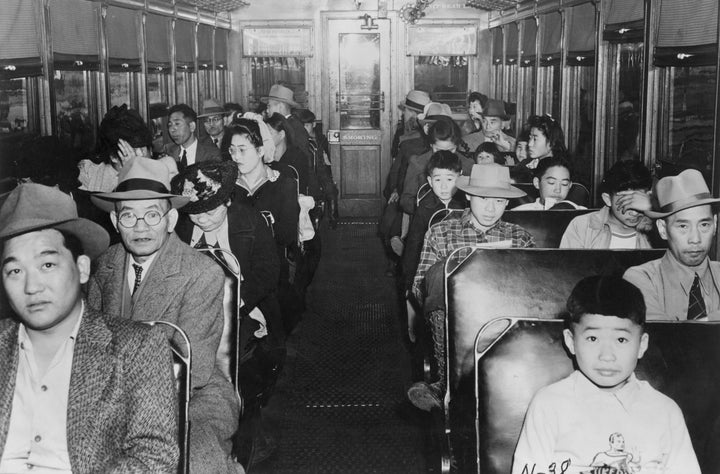
Today marks the 75th anniversary of President Franklin D. Roosevelt’s signing of the executive order that authorized the internment of 120,000 men, women, and children of Japanese descent during World War II. As we contemplate the actions of the Trump administration in matters pertaining to national security, it is imperative that we remember and reflect upon this lesson from the past.
In the immediate aftermath of the Japanese attack on Pearl Harbor on December 7, 1941, there was no clamor for the mass internment of persons of Japanese descent. To the contrary, shortly after Pearl Harbor, Attorney General Francis Biddle assured the nation that there would be “no indiscriminate, large-scale raids” on such individuals, and Congressman John M. Coffee expressed his “fervent hope” that “residents of the United States of Japanese extraction will not be made the victim of pogroms directed by self-proclaimed patriots.”
In the weeks that followed, however, a demand for the removal of all persons of Japanese ancestry—citizens and non-citizens alike — exploded along the West Coast. The motivations for this sudden outburst of anxiety were many and complex. In part, this demand was fed by panic-driven fears of a possible Japanese invasion of the mainland. Conspiracy theories abounded, and neither government nor military officials did anything to allay these anxieties.
General John L. DeWitt, the top Army commander on the West Coast, reported as true a fabricated report of an imminent uprising of 20,000 Japanese Americans in San Francisco. FBI Director J. Edgar Hoover publicly dismissed this hysteria as unwarranted, and Attorney General Biddle repeatedly reiterated that no person would be detained “on the score of nationality alone.”
Public agitation for a mass evacuation of all persons of Japanese ancestry was inflamed, however, by a California legislative manifesto that purported to connect the ethnic Japanese with an alleged fifth column, asserting that even ethnic Japanese born in this country are “totally unassimilable” and insisting that every American of Japanese ancestry had primary allegiance “to his Emperor and to Japan.”
“General John L. DeWitt, the top Army commander on the West Coast, reported as true a fabricated report of an imminent uprising of 20,000 Japanese Americans in San Francisco.”
On January 4, 1942, newspaper columnist Damon Runyon falsely reported that a radio transmitter had been discovered in a rooming house that catered to Japanese residents. Who could “doubt,” Runyon asked, the “continued existence of enemy agents” among the Japanese population? On January 14, Republican Congressman Leland M. Ford demanded that “all Japanese, whether citizens or not, be placed in inland concentration camps.”
Such demands were further ignited by the Report of the Commission on Pearl Harbor, which was released on January 25, 1942. Hastily researched and written, this report falsely asserted that persons of Japanese ancestry had engaged in espionage and facilitated Japan’s attack on the United States. Although these assertions were unfounded, the report played a key role in turning Americans against Americans. Shortly after the report was released, Henry McLemore wrote a column in the San Fransisco Examiner calling for “the immediate removal of every Japanese on the West Coast.” He added: “Personally, I hate the Japanese. And that goes for all of them.”
On February 4, California Governor Culbert Olson declared in a radio address that it was “much easier” to determine the loyalty of Italian and German aliens than of Japanese Americans, and that “all Japanese people, I believe, will recognize this fact.” California’s Governor, the Mayor of Los Angeles, and most members of the West Coast congressional delegations now demanded that all persons of Japanese ancestry be removed from the West Coast.
California Attorney General (and future Supreme Court Justice) Earl Warren argued that, unlike the situation with respect to Germans and Italians, it was simply too difficult to determine which Americans of Japanese ancestry were loyal, and which were not. General DeWitt added that, “you needn’t worry about the Italians, except in certain cases” and “the same for the Germans.” But “a Jap’s a Jap.”
In early February, Attorney General Biddle, resisting growing pressure for internment, informed President Roosevelt that J. Edgar Hoover had concluded that the demand for mass evacuation was based on “public hysteria” and rampant misinformation. Biddle added that the Department of Justice “would have nothing to do” with any mass evacuation of Japanese Americans.
The public clamor on the West Coast, however, continued to build. American “patriots” began to commit ugly acts of vigilantism and vandalism against Japanese Americans and their property. On February 19, President Roosevelt signed Executive Order 9066. Over the next eight months, 120,000 individuals of Japanese ancestry, two-thirds of whom were American citizens, were ordered to leave their homes. They were assigned to temporary detention camps, which had been set up in converted race tracks and fairgrounds. Many families lived in crowded horse stalls, often in unsanitary conditions. Barbed wire fences and armed guard towers surrounded the compounds.
From there, the internees were transported to one of ten permanent internment camps, which were located in isolated areas in wind-swept deserts or vast swamplands. Men, women, and children were placed in overcrowded rooms with no furniture other than cots. And there they remained for three years. Many of these families lost all of their possessions, to say nothing of their liberty and their dignity.
“American “patriots” began to commit ugly acts of vigilantism and vandalism against Japanese Americans and their property.”
The public rationale for the decision, laid out in the Final Report on the Evacuation of the Japanese from the West Coast, was that time was of the essence and that the government had no reasonable way to distinguish loyal from disloyal persons of Japanese descent. This report has rightly been condemned as a travesty. It relied upon unsubstantiated and even fabricated assertions.
Why, then, did Roosevelt sign the executive order? Undoubtedly, public opinion played a key role in his thinking. Although Roosevelt purported to explain the order in terms of military necessity, there is little doubt that domestic politics played a role in his thinking. 1942 was an election year. Roosevelt was not prepared to stand up to the growing panic, even though he knew it to be based on false information and public hysteria.
In Korematsu v. United States, decided in 1944, the Supreme Court, deferring to the judgment of military authorities, upheld the constitutionality of the Japanese internment. In a memorable dissenting opinion, Justice Frank Murphy courageously declared that “no adequate reason is given for the failure to treat these Japanese Americans on an individual basis, as was done in the case of persons of German and Italian ancestry. . . . I dissent, therefore, from this legalization of racism.”
In a separate dissenting opinion, Justice Robert Jackson insisted that the Court must not “distort the Constitution to approve all that the military may deem expedient,” adding that “once a judicial opinion rationalizes such an order to show that it conforms to the Constitution, . . . the principle then lies about like a loaded weapon ready for the hand of any authority that can bring forward a plausible claim of an urgent need.”
On February 19, 1976, as part of the celebration of the Bicentennial of the Constitution, President Gerald Ford issued Presidential Proclamation 4417, in which he acknowledged that, in the spirit of celebrating our Constitution, we must recognize “our national mistakes as well as our national achievements.” “February 19th,” he noted, “is the anniversary of a sad day in American history,” for it was “on that date in 1942 . . . that Executive Order 9066 was issued.”
President Ford observed that “we now know what we should have known then” – that the evacuation and internment of loyal Japanese American citizens was “wrong.” Ford concluded by calling “upon the American people to affirm with me this American Promise – that we have learned from the tragedy of that long-ago experience” and “resolve that this kind of action shall never again be repeated.”
In 1983, Congress appointed the Commission on Wartime Relocation and Internment of Civilians to review Executive Order 9066. The Commission unanimously concluded that the factors that shaped the internment decision “were race prejudice, war hysteria and a failure of political leadership,” not any genuine military necessity. The Commission recommended that “Congress pass a joint resolution, to be signed by the President, which recognizes that a grave injustice was done and offers the apologies of the nation for the acts of exclusion, removal and detention.”
In 1988, President Ronald Reagan signed the Civil Liberties Act of 1988, which officially declared that the Japanese internment was a “grave injustice” that was “carried out without adequate security reasons” and without any documented acts of “espionage or sabotage.” The Act offered an official Presidential apology and reparations to each of the Japanese-American internees who had suffered discrimination, loss of liberty, loss of property, and personal humiliation because of the actions of the United States government. Over the years, the Supreme Court’s decision in Korematsu has become a constitutional pariah.
As we move forward in the face of a president’s call for a “Muslim ban” and who knows what else in the future, it is imperative that we remember, reflect upon, and remain eternally vigilant against our capacity to do evil in the name of national security.
